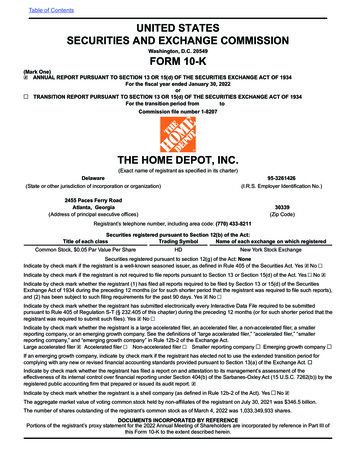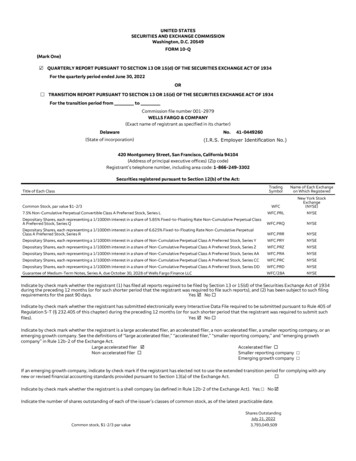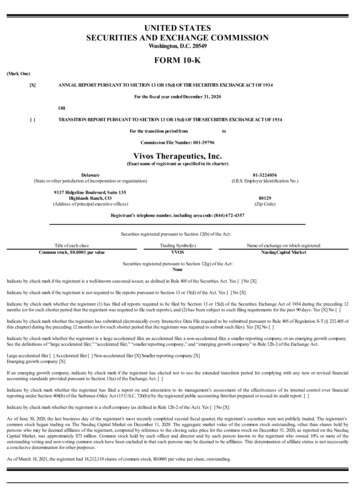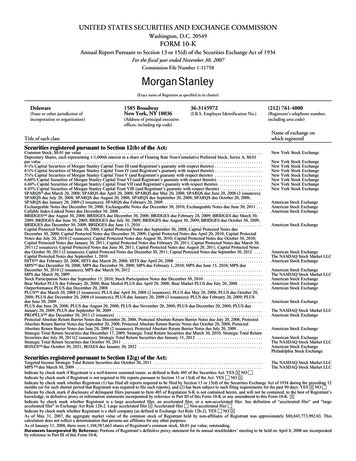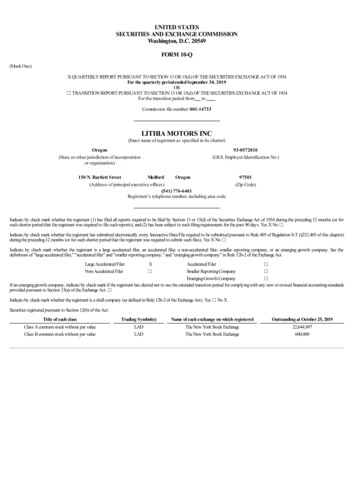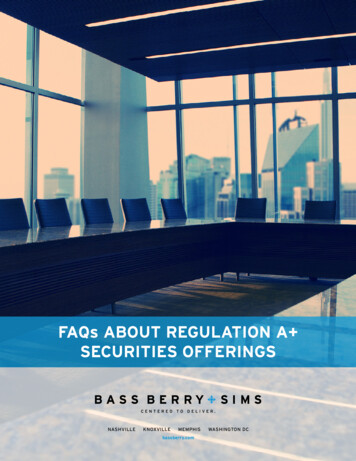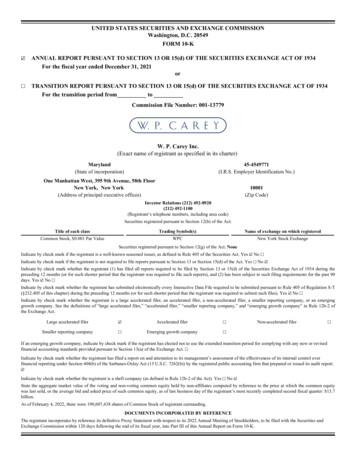
Transcription
UNITED STATES SECURITIES AND EXCHANGE COMMISSIONWashington, D.C. 20549FORM 10-K ANNUAL REPORT PURSUANT TO SECTION 13 OR 15(d) OF THE SECURITIES EXCHANGE ACT OF 1934For the fiscal year ended December 31, 2021or TRANSITION REPORT PURSUANT TO SECTION 13 OR 15(d) OF THE SECURITIES EXCHANGE ACT OF 1934For the transition period from toCommission File Number: 001-13779W. P. Carey Inc.(Exact name of registrant as specified in its charter)Maryland(State of incorporation)45-4549771(I.R.S. Employer Identification No.)One Manhattan West, 395 9th Avenue, 58th FloorNew York, New York(Address of principal executive offices)10001(Zip Code)Investor Relations (212) 492-8920(212) 492-1100(Registrant’s telephone numbers, including area code)Securities registered pursuant to Section 12(b) of the Act:Title of each classTrading Symbol(s)Name of exchange on which registeredCommon Stock, 0.001 Par ValueWPCNew York Stock ExchangeSecurities registered pursuant to Section 12(g) of the Act: NoneIndicate by check mark if the registrant is a well-known seasoned issuer, as defined in Rule 405 of the Securities Act. Yes No Indicate by check mark if the registrant is not required to file reports pursuant to Section 13 or Section 15(d) of the Act. Yes No Indicate by check mark whether the registrant (1) has filed all reports required to be filed by Section 13 or 15(d) of the Securities Exchange Act of 1934 during thepreceding 12 months (or for such shorter period that the registrant was required to file such reports), and (2) has been subject to such filing requirements for the past 90days. Yes No Indicate by check mark whether the registrant has submitted electronically every Interactive Data File required to be submitted pursuant to Rule 405 of Regulation S-T(§232.405 of this chapter) during the preceding 12 months (or for such shorter period that the registrant was required to submit such files). Yes No Indicate by check mark whether the registrant is a large accelerated filer, an accelerated filer, a non-accelerated filer, a smaller reporting company, or an emerginggrowth company. See the definitions of “large accelerated filer,” “accelerated filer,” “smaller reporting company,” and “emerging growth company” in Rule 12b-2 ofthe Exchange Act.Large accelerated filer Accelerated filer Smaller reporting company Emerging growth company Non-accelerated filer If an emerging growth company, indicate by check mark if the registrant has elected not to use the extended transition period for complying with any new or revisedfinancial accounting standards provided pursuant to Section 13(a) of the Exchange Act. Indicate by check mark whether the registrant has filed a report on and attestation to its management’s assessment of the effectiveness of its internal control overfinancial reporting under Section 404(b) of the Sarbanes-Oxley Act (15 U.S.C. 7262(b)) by the registered public accounting firm that prepared or issued its audit report. Indicate by check mark whether the registrant is a shell company (as defined in Rule 12b-2 of the Act). Yes No State the aggregate market value of the voting and non-voting common equity held by non-affiliates computed by reference to the price at which the common equitywas last sold, or the average bid and asked price of such common equity, as of last business day of the registrant’s most recently completed second fiscal quarter: 13.7billion.As of February 4, 2022, there were 190,607,438 shares of Common Stock of registrant outstanding.DOCUMENTS INCORPORATED BY REFERENCEThe registrant incorporates by reference its definitive Proxy Statement with respect to its 2022 Annual Meeting of Stockholders, to be filed with the Securities andExchange Commission within 120 days following the end of its fiscal year, into Part III of this Annual Report on Form 10-K.
INDEXPage No.PART IItem 1.Item 1A.Item 1B.Item 2.Item 3.Item 4.PART IIItem 5.Item 6.Item 7.Item 7A.Item 8.Item 9.Item 9A.Item 9B.Item 9C.PART IIIItem 10.Item 11.Item 12.BusinessRisk FactorsUnresolved Staff CommentsPropertiesLegal ProceedingsMine Safety Disclosures3720202020Market for Registrant’s Common Equity, Related Stockholder Matters and Issuer Purchases ofEquity SecuritiesReservedManagement’s Discussion and Analysis of Financial Condition and Results of OperationsQuantitative and Qualitative Disclosures About Market RiskFinancial Statements and Supplementary Data2122224749Changes in and Disagreements With Accountants on Accounting and Financial DisclosureControls and ProceduresOther InformationDisclosure Regarding Foreign Jurisdictions that Prevent Inspections131131131132Directors, Executive Officers and Corporate GovernanceExecutive CompensationSecurity Ownership of Certain Beneficial Owners and Management and Related StockholderMattersCertain Relationships and Related Transactions, and Director IndependencePrincipal Accounting Fees and Services133133Item 13.Item 14.PART IVItem 15.Exhibits and Financial Statement SchedulesItem 16.Form 10-K SummarySIGNATURES133133133134140W. P. Carey 2021 10-K – 1
Forward-Looking StatementsThis Annual Report on Form 10-K (the “Report”) including Management’s Discussion and Analysis of Financial Condition andResults of Operations in Item 7 of Part II of this Report, contains forward-looking statements within the meaning of the federalsecurities laws. These forward-looking statements generally are identified by the words “believe,” “project,” “expect,”“anticipate,” “estimate,” “intend,” “strategy,” “plan,” “may,” “should,” “will,” “would,” “will be,” “will continue,” “will likelyresult,” and similar expressions. These forward-looking statements include, but are not limited to, statements regarding: ourcorporate strategy and estimated or future economic performance and results, including the general economic outlook and ourexpectations surrounding the continued impact of the novel coronavirus (“COVID-19”) pandemic on our business, financialcondition, liquidity, results of operations, and prospects; underlying assumptions about our portfolio, including tenant rentcollections and bankruptcies, as well as the estimated fair value of our investments and properties; the amount and timing of anyfuture dividends; our future capital expenditure and leverage levels, debt service obligations, and any plans to fund our futureliquidity needs; prospective statements regarding our access to the capital markets, including related to our credit ratings, abilityto sell shares under our “at-the-market” program (“ATM Program”), and settlement of our Equity Forwards (as defined herein);the outlook for the investment programs that we manage, including possible liquidity events for those programs; statements thatwe make regarding our ability to remain qualified for taxation as a real estate investment trust (“REIT”); and the impact ofrecently issued accounting pronouncements and other regulatory activity.These statements are based on the current expectations of our management. It is important to note that our actual results couldbe materially different from those projected in such forward-looking statements. There are a number of risks and uncertaintiesthat could cause actual results to differ materially from these forward-looking statements. Other unknown or unpredictable risksor uncertainties, like the risks related to the effects of pandemics and global outbreaks of contagious diseases (such as thecurrent COVID-19 pandemic) or the fear of such outbreaks, could also have material adverse effects on our business, financialcondition, liquidity, results of operations, and prospects. You should exercise caution in relying on forward-looking statementsas they involve known and unknown risks, uncertainties, and other factors that may materially affect our future results,performance, achievements, or transactions. Information on factors that could impact actual results and cause them to differfrom what is anticipated in the forward-looking statements contained herein is included in this Report, as well as in our otherfilings with the Securities and Exchange Commission (“SEC”), including but not limited to those described in Item 1A. RiskFactors and Item 7. Management’s Discussion and Analysis of Financial Condition and Results of Operations of this Report.Moreover, because we operate in a very competitive and rapidly changing environment, new risks are likely to emerge fromtime to time. Given these risks and uncertainties, potential investors are cautioned not to place undue reliance on these forwardlooking statements as a prediction of future results, which speak only as of the date of this presentation, unless noted otherwise.Except as required by federal securities laws and the rules and regulations of the SEC, we do not undertake to revise or updateany forward-looking statements.All references to “Notes” throughout the document refer to the footnotes to the consolidated financial statements of theregistrant in Part II, Item 8. Financial Statements and Supplementary Data.W. P. Carey 2021 10-K – 2
PART IItem 1. Business.General Development of BusinessW. P. Carey Inc. (“W. P. Carey”), together with our consolidated subsidiaries and predecessors, is an internally-manageddiversified REIT and a leading owner of commercial real estate, net-leased to companies located primarily in the United Statesand Northern and Western Europe on a long-term basis. The vast majority of our revenues originate from lease revenueprovided by our real estate portfolio, which is comprised primarily of single-tenant industrial, warehouse, office, retail, and selfstorage facilities that are critical to our tenants’ operations. Our portfolio is comprised of 1,304 properties, net-leased to 352tenants in 24 countries. As of December 31, 2021, approximately 63% of our contractual minimum annualized base rent(“ABR”) was generated by properties located in the United States and approximately 35% was generated by properties locatedin Europe. As of that same date, our portfolio included 20 operating properties, comprised of 19 self-storage properties and onehotel.We also earn fees and other income by managing the portfolios of two remaining non-traded investment programs through ourinvestment management business. We no longer sponsor new investment programs.Founded in 1973, we became a publicly traded company listed on the New York Stock Exchange (“NYSE”) in 1998 andreorganized as a REIT in 2012. Our shares of common stock are listed on the NYSE under the ticker symbol “WPC.”Headquartered in New York, we also have offices in Dallas, London, and Amsterdam. For discussion of the impact of theCOVID-19 pandemic on our business, see Item 1A. Risk Factors and Item 7. Management’s Discussion and Analysis ofFinancial Condition and Results of Operations — Significant Developments.Narrative Description of BusinessBusiness Objectives and StrategyOur primary business objective is to invest in a diversified portfolio of high-quality, mission-critical assets subject to long-termnet leases with built-in rent escalators for the purpose of generating stable cash flows, enabling us to grow our dividend andincrease long-term stockholder value.Our investment strategy primarily focuses on owning and actively managing a diverse portfolio of commercial real estate that isnet-leased to credit-worthy companies. We review and evaluate the fundamental value of the underlying real estate. We believethat many companies prefer to lease rather than own their corporate real estate because it allows them to deploy their capitalmore effectively into their core competencies. We specialize in sale-leaseback transactions, where we acquire a company’scritical real estate and then lease it back to them on a long-term, triple-net basis, which requires them to pay substantially all ofthe costs associated with operating and maintaining the property (such as real estate taxes, insurance, and facility maintenance).Compared to other types of real estate investments, sale-leaseback transactions typically produce a more predictable incomestream and require minimal capital expenditures, which in turn generate revenues that provide our stockholders with a stable,growing source of income.We believe that diversification across property type, tenant, tenant industry, and geographic location, as well as diversificationof our lease expirations and scheduled rent increases, are vital aspects of portfolio risk management and accordingly haveconstructed a portfolio of real estate that we believe is well-diversified across each of these categories. We capitalize on ourlarge portfolio and existing tenant relationships through accretive expansions, renovations, and follow-on deals. We activelymanage our real estate portfolio to monitor tenant credit quality and lease renewal risks. We also maintain ample liquidity, aconservative capital structure, and access to multiple forms of capital.Our business operates in two segments: Real Estate and Investment Management, as described herein and in Note 1. Our RealEstate segment generates the vast majority of our earnings through the lease revenues we earn from our real estate investments.Through our Investment Management segment, we earn asset management fees and other compensation from the managementof 2.7 billion of assets of the following entities: (i) Corporate Property Associates 18 – Global Incorporated (“CPA:18 –Global”) and (ii) Carey European Student Housing Fund I, L.P. (“CESH”). On April 13, 2020, two of our former investmentprograms, Carey Watermark Investors Incorporated (“CWI 1”) and Carey Watermark Investors 2 Incorporated (“CWI 2”)(together, the “CWI REITs”), merged in an all-stock transaction (the “CWI 1 and CWI 2 Merger”). Following the close of theW. P. Carey 2021 10-K – 3
CWI 1 and CWI 2 Merger, our advisory agreements with CWI 1 and CWI 2 were terminated and CWI 2 was renamedWatermark Lodging Trust, Inc. (“WLT”) (Note 3). As used herein, “Managed REITs” refers to CPA:18 – Global and the CWIREITs (through April 13, 2020). We refer to the Managed REITs and CESH as the “Managed Programs.” We continue to act asthe advisor to the two remaining Managed Programs and currently expect to do so through the end of their respective life cycles(Note 3).We intend to operate our business in a manner that is consistent with the maintenance of our status as a REIT for federal incometax purposes. In addition, we expect to manage our investments in order to maintain our exemption from registration as aninvestment company under the Investment Company Act of 1940, as amended.Investment StrategiesWhen considering potential net-lease investments for our real estate portfolio, we review various aspects of a transaction todetermine whether the investment and lease structure will satisfy our investment criteria. We generally analyze the followingmain aspects of each transaction:Tenant/Borrower Evaluation — We evaluate each potential tenant or borrower for creditworthiness, typically consideringfactors such as management experience, industry position and fundamentals, operating history, and capital structure. We alsorate each asset based on its market, liquidity, and criticality to the tenant’s operations, as well as other factors that may beunique to a particular investment. We seek opportunities where we believe the tenant may have a stable or improving creditprofile or credit potential that has not been fully recognized by the market. We define creditworthiness as a risk-rewardrelationship appropriate to our investment strategies, which may or may not coincide with ratings issued by the credit ratingagencies. We have a robust internal credit rating system and may designate subsidiaries of non-guarantor parent companies withinvestment grade ratings as “implied investment grade.”Properties Critical to Tenant/Borrower Operations — We generally focus on properties and facilities that we believe arecritical to the ongoing operations of the tenant. We believe that these properties generally provide better protection, particularlyin the event of a bankruptcy, since a tenant/borrower is less likely to risk the loss of a critically important lease or property in abankruptcy proceeding or otherwise.Diversification — We attempt to diversify our portfolio to avoid undue dependence on any one particular tenant, borrower,collateral type, geographic location, or industry. By diversifying our portfolio, we seek to reduce the adverse effect of a singleunderperforming investment or a downturn in any particular industry or geographic region. While we do not set any fixeddiversity metrics in our portfolio, we believe that it is well-diversified.Lease Terms — Generally, the net-leased properties we invest in are leased on a full-recourse basis to the tenants or theiraffiliates. In addition, the vast majority of our leases provide for scheduled rent increases over the term of the lease (see OurPortfolio below). These rent increases are either fixed (i.e., mandated on specific dates) or tied to increases in inflation indices(e.g., the Consumer Price Index (“CPI”) or similar indices in the jurisdiction where the property is located), but may containcaps or other limitations, either on an annual or overall basis. In the case of retail stores and hotels, the lease may provide forparticipation in the gross revenues of the tenant above a stated level, which we refer to as percentage rent.Real Estate Evaluation — We review and evaluate the physical condition of the property and the market in which it is located.We consider a variety of factors, including current market rents, replacement cost, residual valuation, property operatinghistory, demographic characteristics of the location and accessibility, competitive properties, and suitability for re-leasing. Weobtain third-party environmental and engineering reports and market studies when required. When considering an investmentoutside the United States, we will also consider factors particular to a country or region, including geopolitical risk, in additionto the risks normally associated with real property investments. See Item 1A. Risk Factors.Transaction Provisions to Enhance and Protect Value — When negotiating leases with potential tenants, we attempt to includeprovisions that we believe help to protect the investment from material changes in the tenant’s operating and financialcharacteristics, which may affect the tenant’s ability to satisfy its obligations to us or reduce the value of the investment. Suchprovisions include covenants requiring our consent for certain activities, requiring indemnification protections and/or securitydeposits, and requiring the tenant to satisfy specific operating tests. We may also seek to enhance the likelihood that a tenantwill satisfy their lease obligations through a letter of credit or guaranty from the tenant’s parent or other entity. Such creditenhancements, if obtained, provide us with additional financial security. However, in markets where competition for net-leasetransactions is strong, some or all of these lease provisions may be difficult to obtain.W. P. Carey 2021 10-K – 4
Competition — We face active competition from many sources, both domestically and internationally, for net-lease investmentopportunities in commercial properties. In general, we believe that our management’s experience in real estate, creditunderwriting, and transaction structuring will allow us to compete effectively for commercial properties. However, competitorsmay be willing to accept rates of return, lease terms, other transaction terms, or levels of risk that we find unacceptable.Asset ManagementWe believe that proactive asset management is essential to maintaining and enhancing property values. Important aspects ofasset management include entering into new or modified transactions to meet the evolving needs of current tenants, re-leasingproperties, credit and real estate risk analysis, building expansions and redevelopments, repositioning assets, sustainability andefficiency analysis and retrofits, and strategic dispositions. We regularly engage directly with our tenants and form long-termworking relationships with their decision makers in order to provide proactive solutions and to obtain an in-depth, real-timeunderstanding of tenant credit.We monitor compliance by tenants with their lease obligations and other factors that could affect the financial performance ofour real estate investments on an ongoing basis, which typically involves ensuring that each tenant has paid real estate taxes andother expenses relating to the properties it occupies and is maintaining appropriate insurance coverage. To ensure suchcompliance at our properties, we often engage the expertise of third parties to complete property inspections. We also reviewtenant financial statements and undertake regular physical inspections of the properties to verify their condition andmaintenance. Additionally, we periodically analyze each tenant’s financial condition, the industry in which each tenantoperates, and each tenant’s relative strength in its industry. The in-depth understanding of our tenants’ businesses and directrelationships with their management teams provides strong visibility into potential issues as well as additional investmentopportunities. Our business intelligence platform provides real-time surveillance and early warning, allowing asset managers towork with tenants to enforce lease provisions, and where appropriate, consider lease modifications. Our proactive assetmanagement philosophy has proven particularly applicable during the COVID-19 pandemic.Financing StrategiesWe believe in maintaining ample liquidity, a conservative capital structure, and access to multiple forms of capital. We preservebalance sheet flexibility and liquidity by maintaining significant capacity on our 1.8 billion unsecured revolving credit facility(the “Unsecured Revolving Credit Facility”), as well as any amounts available to us under our term loan (“Term Loan”) anddelayed draw term loan (“Delayed Draw Term Loan”), which, together with our Unsecured Revolving Credit Facility, we referto collectively as our “Senior Unsecured Credit Facility.” We generally use the Unsecured Revolving Credit Facility to fund ourimmediate capital needs, including new acquisitions and the repayment of secured mortgage debt as we continue to unencumberassets. We seek to replace short-term financing with more permanent forms of capital, including, but not limited to, commonstock, unsecured debt securities, bank debt, and proceeds from asset sales. When evaluating which form of capital to pursue, wetake into consideration multiple factors, including our corporate leverage levels and targets, and the most attractive source ofcapital available to us. We may choose to issue unsecured debt securities and bank debt denominated in foreign currencies inpart to fund international acquisitions, unencumber assets, and mitigate our exposure to fluctuations in exchange rates. Westrive to maintain an investment grade rating, which places limitations on the amount of leverage acceptable in our capitalstructure. Although we expect to continue to have access to a wide variety of capital sources and maintain our investment graderating, there can be no assurance that we will be able to do so in the future.Our PortfolioAt December 31, 2021, our portfolio had the following characteristics: Number of properties — full or partial ownership interests in 1,304 net-leased properties, 19 self-storage properties,and one hotel;Total net-leased square footage — approximately 156 million; andOccupancy rate — approximately 98.5%.For more information about our portfolio, see Item 7. Management’s Discussion and Analysis of Financial Condition andResults of Operations — Portfolio Overview.W. P. Carey 2021 10-K – 5
Tenant/Lease InformationAt December 31, 2021, our tenants/leases had the following characteristics: Number of tenants — 352;Investment grade tenants as a percentage of total ABR — 22%;Implied investment grade tenants as a percentage of total ABR — 8%;Weighted-average lease term — 10.8 years;99.4% of our leases provide rent adjustments as follows: CPI and similar — 58.7% Fixed — 36.9% Other — 3.8%Human CapitalInvesting in Our EmployeesAt December 31, 2021, we had 183 employees, 129 of which were located in the United States and 54 of which were located inEurope. We strive to make W. P. Carey a great place to work by attracting a diverse pool of the best and brightest applicantsand making them feel supported and included as they progress and grow with the company. We offer various levels of training,including management training, executive training, skills training, and “Respect in the Workplace” training, in addition to our“Conversations at Carey” educational program. By engaging with our employees and investing in their careers through trainingand development, we have built a talented workforce capable of executing our business strategies.DiversityWe believe that our success is dependent upon the diverse backgrounds and perspectives of our employees and directors. W. P.Carey is an equal opportunity employer and considers qualified applicants regardless of race, color, religion, sexual orientation,gender, gender identity or expression, national origin, age, disability, military or veteran status, genetic information, or otherstatuses protected by applicable federal, state, and local law. In 2020, we launched our diversity and inclusion initiative, whichis designed to facilitate conversations around race, sexual orientation and gender identity, national origin, creeds, and otherimportant topics. These conversations, led by our Diversity & Inclusion Advisory Committee, provide a forum for us totranslate our positions as a company into action in both our internal and external communities. We are also signatory to theCEO Action Pledge for Diversity & Inclusion, which reflects our commitment to fostering a more diverse and inclusiveworkforce.Employee Wellness and BenefitsThe health and wellness of our employees and their families are paramount and our comprehensive benefits package is designedto address the changing needs of employees and their dependents. In addition to robust health and wellness benefits, we alsoprovide our employees with competitive compensation programs, with a focus on both current compensation and retirementplanning for their future.To enhance transparency and maintain a sense of community during the COVID-19 pandemic, we have communicatedfrequently through town halls, virtual seminars, and emails. We also reinforced the availability of our corporate benefits,including telemedicine and confidential counseling, and provided additional resources for managing stress, anxiety, andisolation.Additional information regarding our human capital programs and initiatives is available in our annual Proxy Statement andEnvironmental, Social, and Governance (“ESG”) Report, which can be found on our company website. Information on ourwebsite, including our ESG Report, is not incorporated by reference into this Report.W. P. Carey 2021 10-K – 6
Available InformationWe will supply to any stockholder, upon written request and without charge, a copy of this Report as filed with the SEC. Ourfilings can also be obtained for free on the SEC’s website at http://www.sec.gov. All filings we make with the SEC, includingthis Report, our quarterly reports on Form 10-Q, and our current reports on Form 8-K, as well as any amendments to thosereports, are available for free on the Investor Relations portion of our website (http://www.wpcarey.com), as soon as reasonablypracticable after they are filed with or furnished to the SEC.Our quarterly earnings conference call and investor presentations are accessible by the public. We generally announce via pressrelease the dates and conference call details for upcoming scheduled quarterly earnings announcements and webcast investorpresentations, which are also available in the Investor Relations section of our website approximately ten days prior to theevent.Our Code of Business Conduct and Ethics, which applies to all employees, including our chief executive officer and chieffinancial officer, is also available on our website. We intend to make available on our website any future amendments orwaivers to our Code of Business Conduct and Ethics within four business days after any such amendments or waivers. We areproviding our website address solely for the information of investors and do not intend for it to be an active link. We do notintend to incorporate the information contained on our website into this Report or other documents filed with or furnished to theSEC.Item 1A. Risk Factors.Our business, results of operations, financial condition, and ability to pay dividends could be materially adversely affected byvarious risks and uncertainties, including those enumerated below, which could cause such results to differ materially fromthose in any forward-looking statements. You should not consider this list exhaustive. New risk factors emerge periodically andwe cannot assure you that the factors described below list all risks that may become material to us at any later time.Risks Related to Our Portfolio and Ownership of Real EstateWe face an increasingly competitive marketplace for investments.The net lease financing market is perceived as a relatively conservative investment vehicle and there has been increasing capitalinflows into our sector; accordingly, we face escalating competition for investments, both domestically and internationally. Wecompete for investments with many other financial institutions and investors, including other REITs, private equity firms,pension funds, and finance companies. Our competitors may accept greater risk or lower returns, allowing them to offer moreattractive terms to prospective tenants. Further capital inflows into our sect
Item 1. Business. General Development of Business W. P. Carey Inc. ("W. P. Carey"), together with our consolidated subsidiaries and predecessors, is an internally-managed diversified REIT and a leading owner of commercial real estate, net-leased to companies located primarily in the United States
